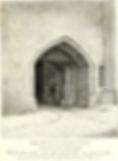Ancient buildings of John Thomas Smith's London
- London On The Ground
- Jun 29, 2024
- 1 min read
Updated: Jun 30, 2024
Late 18th century engravings of London buildings that were already old then (spot the few that remain today!).

John Thomas Smith captured London in the late 18th and early 19th centuries as it underwent massive change and development.
Summer schedule of walks available for booking
For a schedule of forthcoming London On The Ground guided walks through to September, please click here.
The artist, engraver and writer created portrayed buildings, streets and a diverse range of people in the burgeoning metropolis, often just before they were lost.
He also published images of London buildings that had already been demolished.
He wrote and illustrated a number of books on London's antiquities and was well known by Britain's leading artists of his time, including JMW Turner and John Constable.
In a previous post I selected some of the old houses of John Thomas Smith's London.
For this post I have chosen some of his images of public buildings from his book Antiquities of London (published 1791). Only a very small number of these scenes can still be seen today.










Could the arch in the picture above be the one in the office block? Click here for related post.















Summer schedule of walks available for booking
For a schedule of forthcoming London On The Ground guided walks through to September, please click here.
